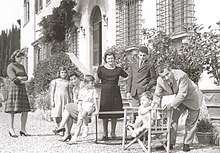Salvatore Ferragamo
Salvatore Ferragamo (5 June 1898 – 7 August 1960) was an Italian shoe designer and the founder of luxury goods high-end retailer Salvatore Ferragamo S.p.A. One of the most innovative shoe designers of the 20th century, Salvatore Ferragamo, rose to fame in the 1930s. In addition to experimenting with unusual materials including kangaroo, crocodile, and fish skin, Ferragamo drew on historic inspiration for his shoes. His cork wedge sandals—often imitated and reimagined—are considered one of the most important shoe designs of the 20th century.
Salvatore Ferragamo | |
|---|---|
 | |
| Born | 5 June 1898 Bonito, Italy |
| Died | 7 August 1960 (aged 62) |
| Nationality | Italian |
| Alma mater | University of Southern California |
| Occupation | Shoe designer |
| Known for | Founder of Salvatore Ferragamo S.p.A.. |
Label(s) | Salvatore Ferragamo |
| Spouse(s) | Wanda Ferragamo |
| Children | 6 |
Early life
Salvatore (registered as "Salvadore") Ferragamo was born in 1898[1] to a poor family in Bonito, Italy, near Avellino, the eleventh of fourteen children of Antonio Ferragamo and Mariantonia Ferragamo (both had the same surname, which often happened in smaller Italian towns). After making his first pair of shoes for himself, a pair of high heels, at age nine (and his sisters to wear at their confirmation), young Salvatore decided that he had found his calling.
Career
After studying shoemaking in Naples for a year, Ferragamo opened a small store based in his parents' home. In 1914, he emigrated to Boston, Massachusetts, where one of his brothers worked in a cowboy boot factory. After a brief stint at the factory, Ferragamo convinced his brothers to move to California, first Santa Barbara then Hollywood. It was there that Ferragamo found success, initially opening a shop for repair and made-to-measure shoes, leading to a long period of designing footwear for the cinema. However, he could not fathom why his shoes pleased the eye yet hurt the foot, so he proceeded to study anatomy at the University of Southern California.
After spending thirteen years in the US, Ferragamo returned to Italy in 1927, settling in Florence. He began to fashion shoes for women, from the Maharani of Cooch Behar to Eva Peron to Marilyn Monroe. He opened a workshop in the Via Mannelli, concentrating his efforts in experimenting with design, applying for patents for ornamental and utility models and some related inventions. Although he filed for bankruptcy in 1933 due to bad management and economic pressures, Ferragamo nonetheless expanded his operation during the 1950s to a workforce of around 700 expert artisans that produced 350 pairs of handmade shoes a day.
"The Rainbow" was created by Salvatore Ferragamo in 1938 and was the first instance of the platform shoe returning in modern days in the West. The platform sandal was designed for American singer and actress Judy Garland. The shoe was a tribute to Garland's signature song "Over the Rainbow" performed in The Wizard of Oz (1939) feature film. The shoe was crafted using shaped slabs of cork that were covered in suede to build up the wedge and gold kidskin was used for the straps. His creation was a result of experimentations with new materials because of wartime rationing during World War II.[2]
Death and legacy
Salvatore Ferragamo died in 1960 at the age of 62, but his name lives on as an international company, which has expanded its operations to include luxury shoes, bags, eyewear, silk accessories, watches, perfumes and a ready-to-wear clothing line. At his death, his wife Wanda and later their six children (Fiamma, Giovanna, Fulvia, Ferruccio, Massimo and Leonardo) ran the company.
His most famous invention is arguably the "Cage heel". Fiamma (Salvatore's eldest daughter who died in 1998) came up with the "Vara pumps" in 1978.
A museum dedicated to Ferragamo's life and work opened in the Palazzo Spini Feroni in 1995.[3] The palazzo had been bought by Ferragamo in the 1930s.
In March 2013, Ferragamo's fashion house, Salvatore Ferragamo S.p.A., established the Ferragamo Foundation in Florence. The foundation was formed to cultivate young fashion designers, based on the ideas of Salvatore Ferragamo.[4]
Present day
The company is owned by the Ferragamo family, which in November 2006 included Salvatore's widow Wanda, five children, 23 grandchildren and other relatives. There is a rule that only three members of the family can work at the company, prompting fierce competition.
Family
- Wanda Ferragamo Miletti led the group since 1960, when her husband and founder of the company, Salvatore, died. She was honorary chairman until her death in 2018.[5]
- Ferruccio Ferragamo, chairman of the company
- Giovanna Gentile-Ferragamo, vice president of Salvatore Ferragamo SpA
- Leonardo Ferragamo, since 2000, has been the Director of Salvatore Ferragamo SpA, Ferragamo Finanziaria; Executive Vice President of the Fondazione Ferragamo.
- Massimo Ferragamo, Chairman of Ferragamo USA.
- Fulvia Visconti-Ferragamo, who died in March 2018, ran the fashion label's silk accessories division beginning in the 1970s. She was the Deputy Chairwoman of Ferragamo Finanziaria SpA.
- Fiamma Ferragamo di San Giuliano, who died in 1998, was involved in the creation of some of the brand's products, such as Vara shoe and the Gancino.
- James Ferragamo, Women's and Men's Shoes and Leather Goods Division Director for the Salvatore Ferragamo Group
- Angelica Visconti Ruspoli, South Europe Director
- Diego Paternò di San Giuliano coordinates the digital activities of the brand.
References
- http://dl.antenati.san.beniculturali.it/v/Archivio+di+Stato+di+Avellino/Stato+civile+italiano/Bonito/Nati/1898/249/101902883_00038.jpg.html
- DeMello, M. (2009). Feet and footwear: A cultural encyclopedia. Santa Barbara, California: Greenwood Press/ABC-CLIO.
- "Ferragamo's return to Italy... 90 years later | Florence Daily News". Florence Daily News. 2017-04-28. Retrieved 2017-11-23.
- Kilcooley-O'Halloran, Scarlett (27 March 2013). "Salvatore Ferragamo Launches Fashion Foundation". Vogue.
- Syme, Rachel (24 October 2018). "Wanda Ferragamo, 96, Dies; Reigned Over Family's Luxury Goods Empire". Retrieved 15 January 2019 – via NYTimes.com.
Further reading
- Ricci, Stefania; Glanz Margo; Mercedes Iturbe (2006). Walking Dreams: Salvatore Ferragamo, 1898-1960.